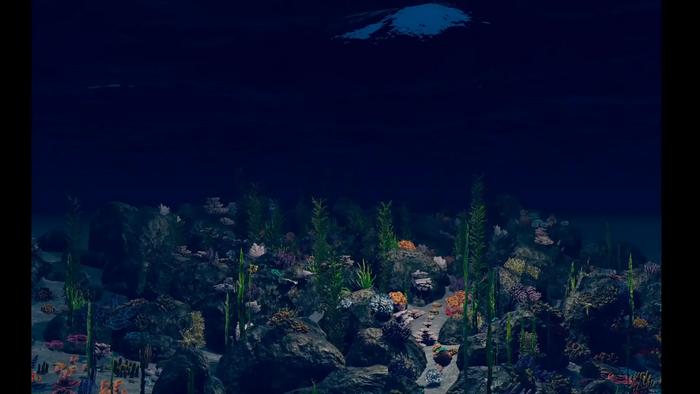UNIVERSITY PARK, Pa. — Depicting worst-case climate scenarios like expanding deserts and dying coral reefs may better motivate people to support environmental policies when delivered via virtual reality, according to a research team led by Penn State that studied how VR and message framing affect the impact of environmental advocacy communications. The study findings, published in the journal Science Communication, may help advocacy groups decide how best to frame and deliver their messages.

Credit: Courtesy of Pejman Sajjadi, Meng Qi Liao and S. Shyam Sundar, Penn State.
UNIVERSITY PARK, Pa. — Depicting worst-case climate scenarios like expanding deserts and dying coral reefs may better motivate people to support environmental policies when delivered via virtual reality, according to a research team led by Penn State that studied how VR and message framing affect the impact of environmental advocacy communications. The study findings, published in the journal Science Communication, may help advocacy groups decide how best to frame and deliver their messages.
The researchers examined individuals’ responses to climate change messaging when delivered through traditional video and desktop virtual reality — VR programs like Google Earth that can run on a mobile phone or computer. They found that loss-framed messages, or those that transitioned from a positive to negative climate scenario to emphasize what humanity has to lose, were more effective at convincing people to support environmental policies when delivered via VR. Gain-framed messages, which depict a more hope-inspiring change from a negative to a positive environmental outcome, had a greater impact when delivered through traditional video format.
“The findings of this study suggest that in terms of seeking support for climate change policy, it’s the combination of the medium and the message that can determine the most effective solution for promoting a particular advocacy message,” said S. Shyam Sundar, senior author and the James P. Jimirro Professor of Media Effects at Penn State. “For consumers, the media literacy message here is that you’re much more emotionally vulnerable or more likely to be swayed by a VR presentation of an advocacy message, especially if the presentation focuses on loss.”
The research team created two desktop virtual reality experiences, one gain-framed and one loss-framed, using the Unity3D game engine. In addition to the loss and gain framed messages, the VR programs also depicted healthy and unhealthy coral reef ecosystems, accompanied by lighter or darker ambient lighting and hopeful or sad audio, and allowed users to explore the aquatic environments. The researchers used the programs to record loss- and gain-framed videos based on the VR experiences.
They chose to depict coral reef ecosystems because corals are one of the species most endangered by the effects of climate change and far removed from many peoples’ lived experiences.
“It’s difficult to communicate environmental issues to non-scientists because the consequences are usually long-term and not easily foreseeable,” said Mengqi Liao, first author and doctoral candidate in mass communication at Penn State. “Not to mention that it’s usually very hard to bring people to an environment that has been damaged by climate change, such as coral reefs, which, based on decades of data collected in part from NASA’s airborne and satellite missions, have declined rapidly over the past 30 years. This is where VR comes in handy. You can bring the environment to people and show them what would happen if we fail to act.”
The researchers recruited 130 participants from Amazon Mechanical Turk and asked them to complete a pre-questionnaire to measure variables like attitudes toward climate change and political ideology. Then they randomly assigned participants to a video or desktop VR experience. Within each of these groups, half saw the gain-framed messaging while the other half saw the loss-framed messaging.
Participants in the loss-framed experiences saw healthy then unhealthy coral ecosystems, with a message explaining the negative consequences of failing to adopt climate change mitigation behaviors. Those in the gain-framed versions saw unhealthy then healthy coral ecosystems, with messages explaining the positive impacts of adopting climate policies. After completing the experiences, participants answered a questionnaire to measure how likely they would be to support environmental policies.
The researchers found that loss-framed messages were most effective at motivating people to support climate change mitigation policies when delivered through desktop VR. Gain-framed messages were most effective when delivered in video format.
Virtual reality is inherently interesting and attention-grabbing, and it has a low cognitive barrier to entry — even small children with limited reading ability can use it, according to Sundar.
“The nickname for VR is empathy machine. It can generate better empathy because you’re one with the environment,” he said. “Loss-framed messaging tends to be more effective, more about emotions like fear rather than hope. Sometimes fear can be better represented in visually resplendent media like VR.”
Gain-framed messaging, on the other hand, tends to involve more thinking about the consequences of action or inaction for the environment and what humans have to gain, Sundar explained. The movement and interactivity that come with VR may distract too much from the kind of thinking needed to process the potential gains highlighted in that type of messaging, which is better suited for traditional video or text.
“With politicized topics like climate change, people are guided by their motivated reasoning, whereby an individual readily accepts information consistent with their worldview and ignores or rejects information that is inconsistent with that view,” Liao said. “Our study suggests that showing stark portrayals of environmental loss can be persuasive in spurring people into action, to support climate change issues regardless of their pre-existing worldviews.”
Pejman Sajjadi, who completed the work as a postdoctoral scholar at Penn State and is now with Meta, also contributed to the research.
Journal
Science Communication
DOI
10.1177/10755470241229453
Article Title
How Does VR Affect Emotional Appeal and Persuasiveness of Gain Versus Loss-Framed Messages?
Article Publication Date
18-Feb-2024




